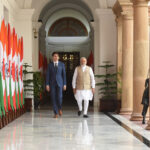Past research on gender and governance has shown that countries where women have greater access to political representation tend to spend less on the military, are less likely to use force in response to international disputes, and are more likely to have a less militarized foreign policy. These findings lend support to the common view in many societies of men as “warriors” and women as “pacifists,” whose gendered traits carry over to influence their policy decisions. From this perspective, a greater female presence in government would lead to a more peaceful foreign policy. Controversy surrounding this claim aside, Theresa Schroeder points out that a country’s foreign policy or level of military aggression is not solely determined by domestic decisions. Rather, the presence of international pressures or threats can play a large role in how a country shapes its policy as a reaction to these issues. In this article, the author is interested in the relationship noted above between the gender balance of political representation and the aggressiveness of foreign policy but approaches the question from a different angle. Assuming the same male = warrior and female = pacifist thinking above, does the threat of an interstate rival cause a country to dismiss female politicians in favor of electing more male politicians who will presumably meet the threat with more aggressive foreign policy and higher military spending?
In most democracies, political leaders are elected through a standard political process: 1) a large pool of people are identified to have the experience and education needed to be qualified to hold public office; 2) political parties select candidates they want to support from this pool of qualified individuals; 3) an electoral system translates votes into the election winners. However, at any given time, the presence of a security threat from a rival can impact steps 2 and 3, as political parties tend to run, and voters tend to prefer, male candidates during times of heightened security concerns. Based on this political process, the author proposes the following hypothesis: female representation will be lower in countries involved in a rivalry compared to countries not involved in a rivalry because of two factors — a decreased demand for female political leaders and the subsequent running of fewer female candidates.
The author considers a rivalry to be present when countries regard one another “as competitor, an enemy, and an explicit threat with each side having the expectation that future interactions may become militarized… Within the rivalry, some level of distrust or conflict between the two states becomes a norm.” The author uses rivalry as a variable due to its long-lasting influence on a country’s domestic politics, compared to a war or dispute, which resolve relatively sooner and typically only have the capacity to impact public opinion over one or two election cycles. To test the impact of rivalries on female representation, the author examines 105 democratic countries and compares those experiencing rivalries to the percentage of seats in the national parliament that are held by women. The rationale behind the author’s hypothesis is that “the ability of men to rise to the top of the political hierarchy hinges on the perception of innate abilities of both men and women.” Because men are often perceived as being better equipped to handle military affairs due to their close association with military experience, particularly combat experience, women are disadvantaged in political elections in states involved in a rivalry.
The results of this study indicate that the level of female representation in government is not entirely a product of domestic beliefs and characteristics — international rivalries do play a noticeable role. Female representation in national parliaments is reduced by half (from 20% to 10%) in states involved in an interstate rivalry compared to states not involved in a rivalry. Additionally, the more rivalries a state is involved in, the more female representation suffers — decreasing to 4% during two rivalries. Interestingly, the author also finds that female representation aligns with overall progress in a country: as the level of development increases so does the number of women in higher education, which in turn increases the number of qualified women in the pool of potential candidates and the number of women elected from that pool.
CONTEMPORARY RELEVANCE
When running for public office, candidates must convince constituents of their ability to face the various foreign and domestic challenges that may arise during their tenure. In the presence of a foreign rivalry, candidates are judged for their perceived ability to present a strong front and their level of support for aggressive policy in the name of security. In this area, female candidates are disadvantaged from the beginning due to stereotypes and assumptions that paint women as meek, in need of protection, or less likely to commit to the sort of aggressive policy thought to be necessary to ward off threats to the nation’s security. Additionally, entire countries are disadvantaged by the gender hierarchies exhibited here, which favor those policies — aggressive, militarized policies — most closely associated with masculinity. The knee-jerk reaction to meet aggression with aggression, as if to prove one’s masculine credentials, can blind society to the way in which such a response can actually create greater insecurity in the context of a rivalry. Instead, such tension can almost always be dissolved through nonviolent diplomatic means, which would, sensibly, be preferred by any constituency that values human life.
Being a man does not qualify you as the honor guard of combat and defense ideals.
It is also important to consider how female representation is affected by security threats not covered in this research. While rivalries between states have proven to be important to the number of women in office, we must also consider the effect of other kinds of security threats and how these have affected female representation. For much of the last 20 years, one of the greatest threats to the security of some countries has been extremist groups such as ISIS or Al Qaida who do not necessarily operate in or on behalf of any one country. If female representation is tied to the stereotypes that suggest men as “warriors” and women as “pacifists,” whose gendered traits presumably carry over to impact their policy decisions, then women are likely to be just as disadvantaged when there are other kinds of security threats thought to require aggressive, militarized responses as when there are long-standing state rivalries, as highlighted in this research.
PRACTICAL IMPLICATIONS
These findings demonstrate the substantial influence international relationships have on domestic politics, indicated by the fact that female representation is not purely a product of domestic opinion. Even when a society has socially and politically evolved to the point of encouraging female representation in its national politics, antiquated gender norms and stereotypes combined with the presence of an international rivalry disadvantage women during elections. The gender stereotypes we apply to political officials are not only inaccurate, they nearly disqualify half the population from representation. Being a man does not qualify you as the honor guard of combat and defense ideals — individuals of all genders act in various ways and possess different experience and knowledge. Furthermore, in many political environments, in order to gain access to power candidates often feel compelled to demonstrate “masculine” qualities aimed at assuring voters of their resolve, strength under pressure, or toughness. This is an easy feat for men, as being more “manly” affirms their gender identity and grants them access to power at the same time. Women, however, are punished for similar attempts — criticized for being either too masculine or not masculine enough. In the case of Hillary Clinton, her perceived lack of “feminine” qualities or surplus of “masculine” qualities often led voters and media pundits to believe she was inauthentic because she did not necessarily display the stereotypical qualities of her gender. In order for women to escape this lose-lose scenario, societies must challenge the premises that assume that so-called “masculine” traits are the more valuable than others, especially in political arenas, or that so-called “masculine” traits are reserved for men.
Looking back on Hillary Clinton’s 2016 presidential campaign, political analysts have commented on various decisions during the campaign made by Clinton and her team that may have jeopardized her chances of winning. One of these mistakes was the decision to frame Clinton to fit the stereotypical mold of a male candidate. In an interview, Clinton’s Communications Director commented on this mistake, stating “we had made her a female facsimile of the qualities that we look for in a male president because there was no other way to think about the president. And I think that’s why people thought she was inauthentic. I think that’s why you hear people say things like there’s something about her I just don’t like.” As the first female presidential candidate from a major party, Clinton and her team lacked the advantage of being able to model their campaign on those of former female candidates and made the decision to run her as they would a male candidate — assuming the voters would be expecting similar characteristics or disposition. In doing so, Clinton displayed mannerisms, like confidence and assertiveness, that society is comfortable with and expects of a man in her position, but many chastised her for this behavior because she is a woman. On the other hand, we can ask, if her campaign team had allowed her to come across as more “feminine,” would she have fared any better? Or would she simply have been criticized for being seemingly too “weak” and not up to the job?
To address the antiquated stereotypes that suggest men as “warriors” and women as “pacifists,” and assumptions about the former, so-called “masculine” traits being more desirable in the political realm, we must energize the emerging national debate around gender hierarchies and inequality, as well as about the roles or jobs to which certain genders more appropriately belong. With this conversation, we can critically examine the false notions associating a particular gender with a specific temperament to reveal the obvious truth that people possess varying characteristics regardless of gender; at the same time, we can also challenge the assumption that these so-called “masculine” characteristics — especially aggressiveness, the willingness to respond militarily, and so on — are more valuable to effective policy-making, even in cases where national security is under threat.
Published in collaboration with the Peace Science Digest, which summarizes and reflects on current academic research in the field of peace and conflict studies. To subscribe or download the full piece, which includes additional resources, visit their website.





















